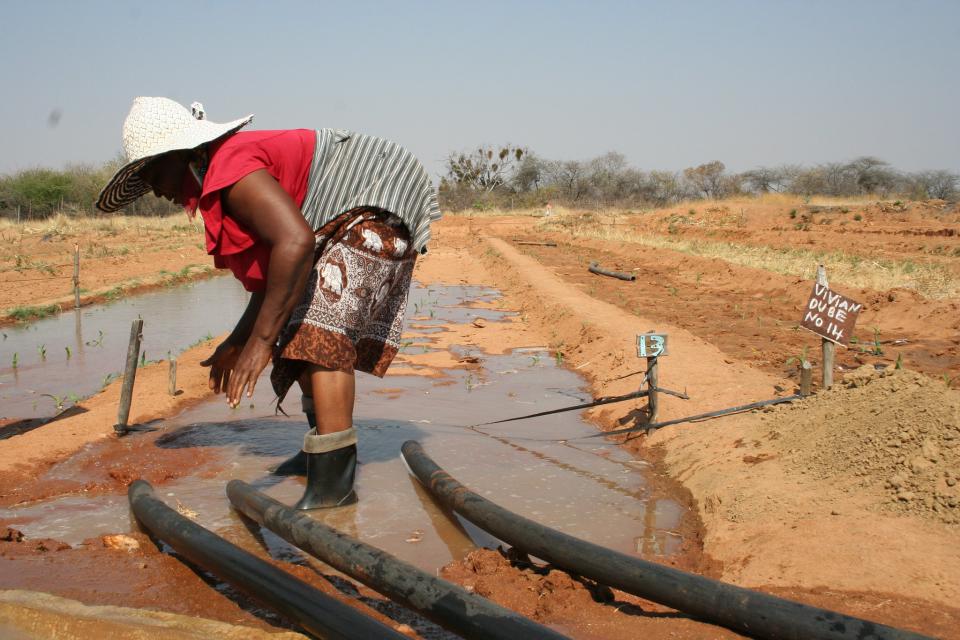Labor-saving technologies designed for women can reduce their drudgery
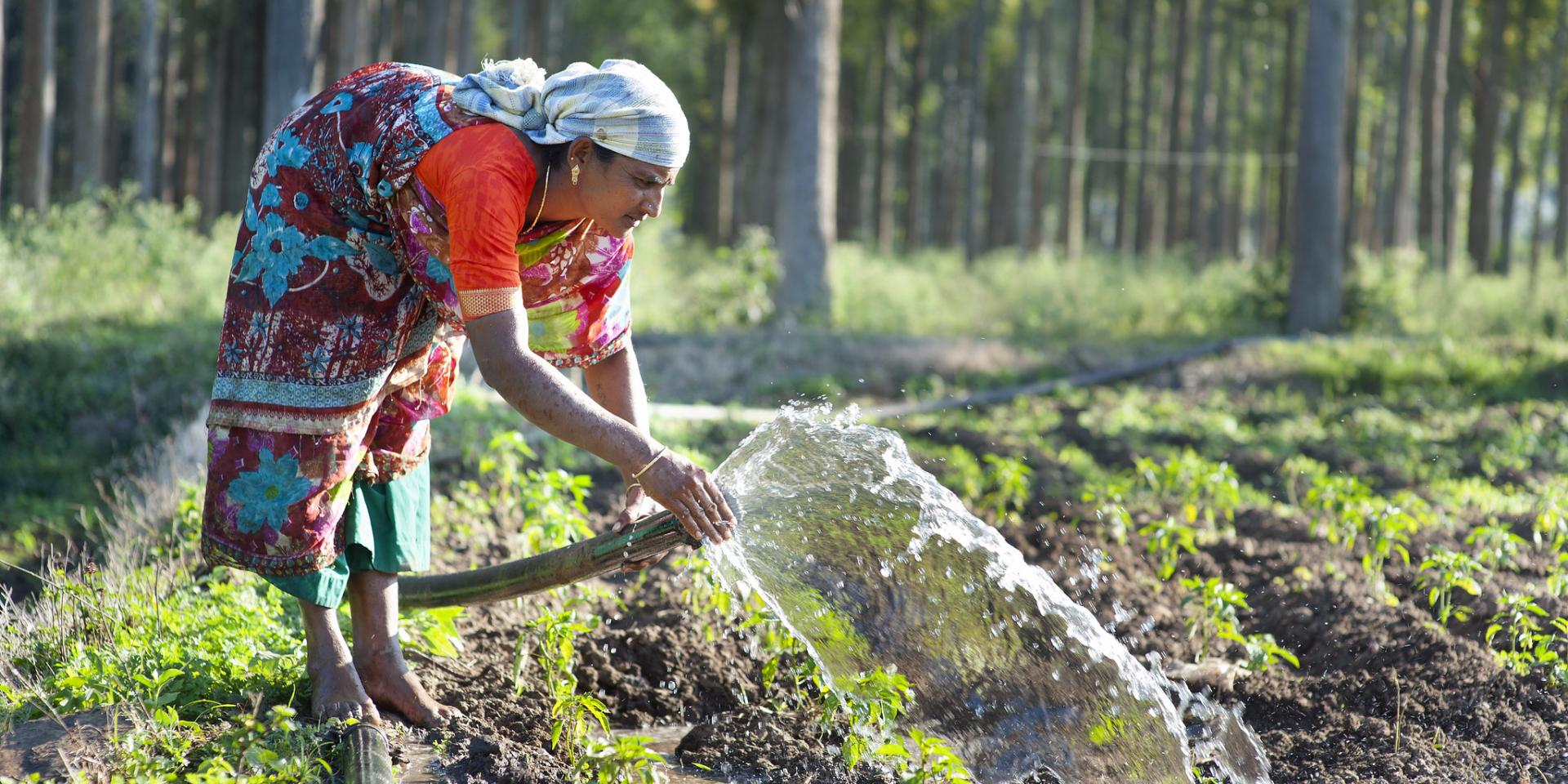 Photo: IWMI
Photo: IWMI
Key messages:
- Labor-saving technologies (LSTs) can relieve women from the time constraints and drudgery involved in working in agriculture and managing household chores. This is particularly relevant given the growing involvement of women in agriculture.
- The rate of women adopting LSTs is low. LSTs are usually designed based on factors important to men, but gendered design considerations can increase their use by women. There is a dearth of research into these factors.
- Information about LSTs is critical for uptake by women or men—but information, extension and social communication about LSTs needs to be tailored for women. Research also needs to expand beyond tractors, and give more attention to women-oriented activities (such as weeding and transplanting), and options for renting LSTs and accessing credit to do so.
- Despite many positives of adopting LSTs, there are negatives, such as labor displacement. We need to consider these trade-offs to evaluate the joint objectives of reducing work burdens and increasing benefits for women.
Recent literature across different contexts suggests that women are becoming more involved in agriculture over time.
Women shoulder most of the domestic household work and spend time in agriculture across all seasons. Agricultural operations are time-consuming and physically draining.
Along with their work burden, women face severe time constraints that may have negative consequences for their nutrition and childcare opportunities and needs.
Adopting labor-saving technologies (LSTs) promises to relieve women from drudgery and time constraints. However, the adoption of LSTs has been low due to several factors.
In a systematic review , we explored these barriers and highlighted the factors that can influence how smallholder and women farmers adopt LSTs in developing countries. We also examined the literature for the impacts of adopting LSTs. Our review revealed notable gaps for future research and detailed the areas that require more research on LSTs to reduce women’s drudgery.
Gendered design and development of LSTs can increase adoption
Our review showed that sustainable adoption of LSTs is possible with considerate efforts to design the right tools.
Currently, most agricultural equipment and tools are designed based on men’s ergonomic factors, without considering women’s ergonomics.
The design of LSTs needs to consider gendered perceptions such as weight, ease of use by women, complexity and labor-saving benefits for men and women. This can contribute to adoption and ensure sustainable use.
Research in this field is negligible: only one quantitative study in our review focused on traits according to gender differences. In view of long-term adoption by women, it becomes imperative to understand the technology-specific perceptions by gender at the design and adoption stages.
Women and men’s different access to information and extension services affects adoption
The importance of information for adoption is widely accepted. Farmers’ access to information is strongly influenced by social networks and access to extension agents. Information needs to be appropriately targeted, considering within-household differences across sociocultural contexts.
Crucial factors influencing adoption of new technologies were found to be:
- the effectiveness of field demonstrations
- hands-on training
- extension agents’ availability
- preference for women extension agents.
Since scholars note differences in access to extension services and social networks among men and women, more research is needed to understand the gender gap in providing and accessing extension services.
Understanding the coverage, accessibility and affordability of LSTs
We found that about 30 percent of the studies we reviewed focused on tractors.
Studies exploring LSTs that cover the breadth of labor-intensive agricultural activities such as weeding or transplanting—where women’s participation is high—were limited. LSTs beyond tractors also need to be researched—including factors such as rental services, credit availability, land ownership and market linkages.
Subsidies and rental markets make LSTs more affordable for smallholder farmers and increase adoption by reducing the cost of capital. However, such arrangements need institutions that enable women to access these technologies.
Ensuring the above factors alone will not guarantee adoption, because individual-level factors influence women’s decisions. More research is needed on the variation in adoption due to intra-household dynamics, risk attitudes, decision-making ability and control of resources by women.
Adopting LSTs can give different results, depending on trade-offs
Our review showed that adopting LSTs is associated with a decline in costs for land preparation and costs associated with labor for sowing and weeding. Time savings, cost reductions and increased labor productivity have been evident across gender after adoption of LSTs.
But few studies have explored the effects on women’s empowerment, nutrition and childcare needs.
Nuanced research is needed to identify the different impacts across gender, landless people and landowners. While there are positive impacts of LST adoption, negative impacts such as labor displacement are likely.
To achieve the joint objectives of reducing work burdens and increasing empowerment, researchers should look at how appropriate technologies are, given the likely trade-offs.
Future work needs to critically evaluate these trade-offs—both for women and within households, as well as across contexts—to minimize any negative consequences.
Suggested citation:
Vemireddy, V., Choudhary, A. 2021. Labor-saving technologies designed for women can reduce their drudgery. CGIAR GENDER PLATFORM Evidence Explainer. Nairobi, Kenya: CGIAR GENDER Platform. https://hdl.handle.net/10568/114807.
References
A systematic review of labor-saving technologies: Implications for women in agriculture
Vemireddy, Vidya, and Anjali Choudhary. 2021. "A systematic review of labor-saving technologies: Implications for women in agriculture. " Global Food Security 29 (100541). https://doi.org/10.1016/j.gfs.2021.100541.

Technology characteristics, farmers’ perceptions and adoption decisions: A Tobit model application in Sierra Leone
Adesina, A. A., and M. M. Zinnah. 1993. “Technology characteristics, farmers’ perceptions and adoption decisions: A Tobit model application in Sierra Leone.” Agricultural Economics 09 (4): 297–311.
Designing Agricultural Technology for African Women Farmers: Lessons from 25 Years of Experience
Cheryl R Doss, “Designing Agricultural Technology for African Women Farmers: Lessons from 25 Years of Experience”, World Development, Volume 29, Issue 12, 2001, Pages 2075-2092, ISSN 0305-750X, https://doi.org/10.1016/S0305-750X(01)00088-2.
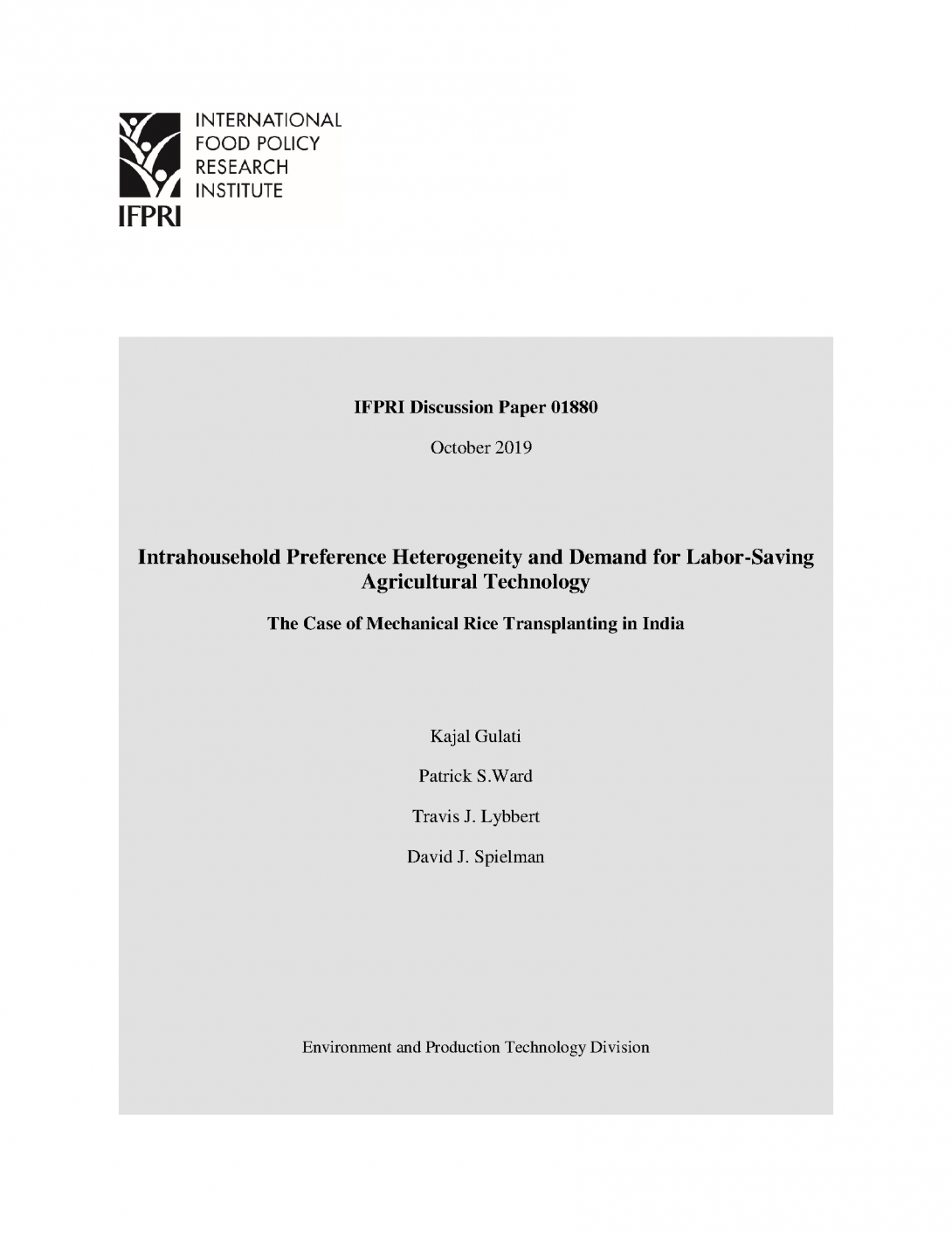
Intrahousehold preference heterogeneity and demand for labor-saving agricultural technology: The case of mechanical rice transplanting in India
Gulati, Kajal; Ward, Patrick S.; Lybbert, Travis J.; and Spielman, David J. 2019. Intrahousehold preference heterogeneity and demand for labor-saving agricultural technology: The case of mechanical rice transplanting in India. IFPRI Discussion Paper 1880. Washington, DC: International Food Policy Research Institute (IFPRI).
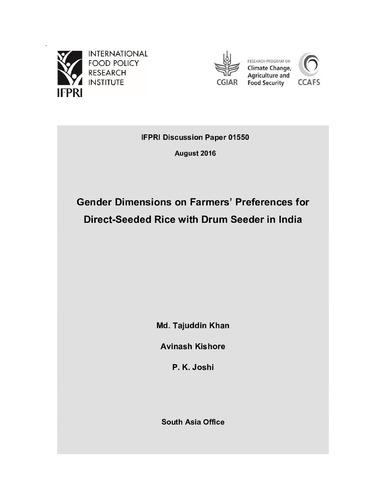
Gender dimensions on farmers’ preferences for direct-seeded rice with drum seeder in India
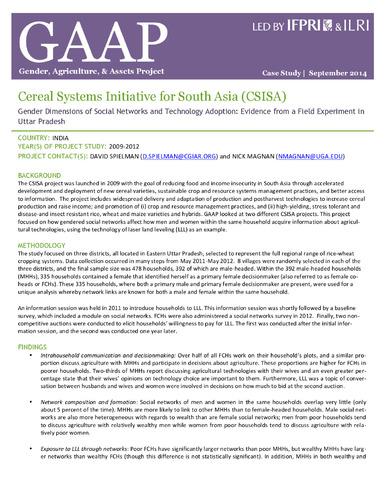
Gender dimensions of social networks and technology adoption: Evidence from a field experiment in Uttar Pradesh
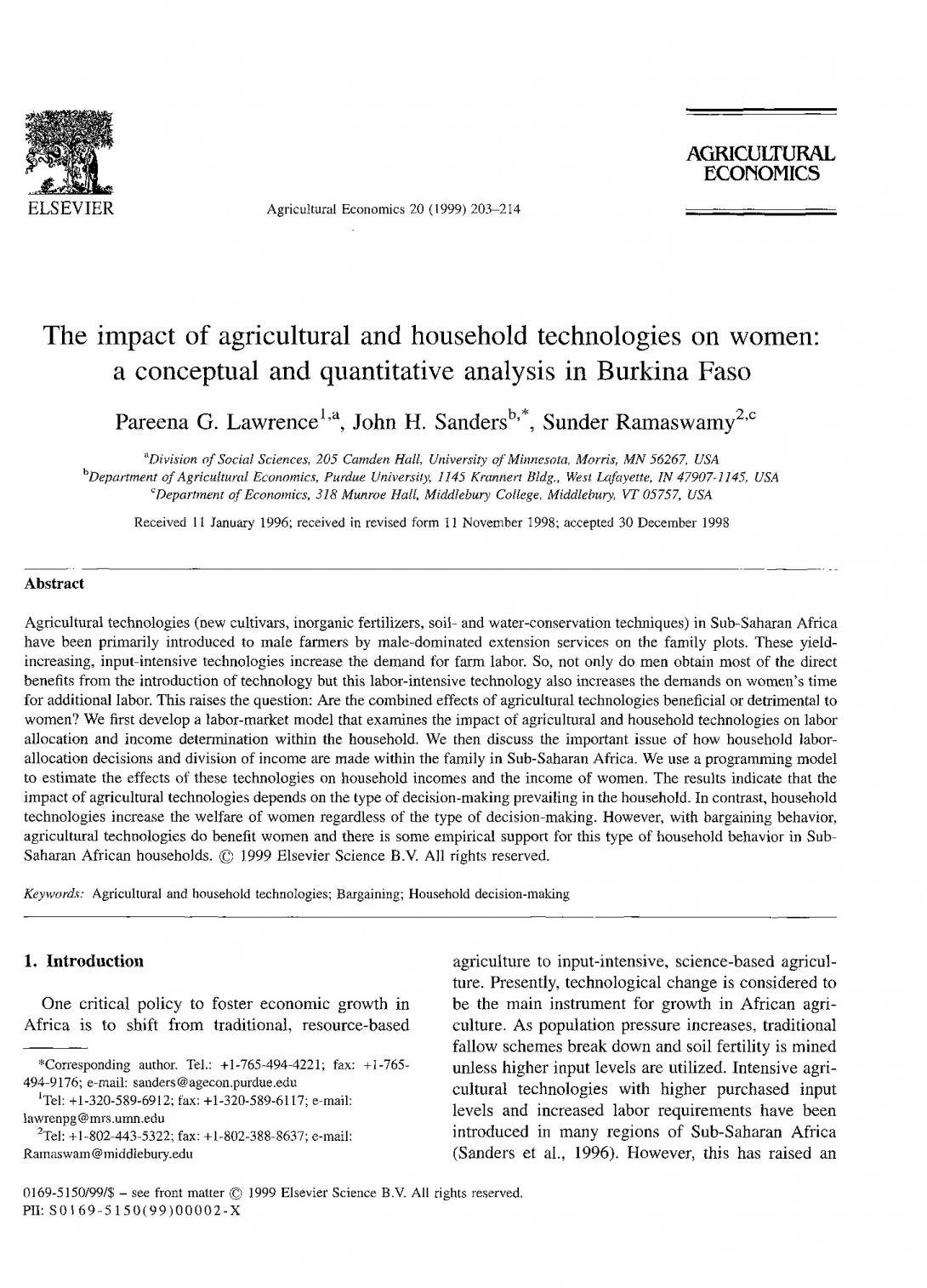
The impact of agricultural and household technologies on women: A conceptual and quantitative analysis in Burkina Faso
Lawrence, P. G., Sanders, J. H., and S. Ramaswamy. 1999. “The impact of agricultural and household technologies on women: A conceptual and quantitative analysis in Burkina Faso.” Agricultural Economics 20 (3): 203-14. https://ageconsearch.umn.edu/record/174976
